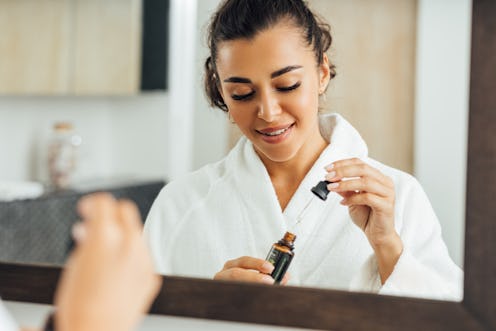Beauty
Derms Explain Exactly How Many Serums You Should Use At Once
And the magic number is...

Serums are the workhorses of your skin care routine and contain the most coveted ingredients for transforming your complexion — think retinoids, chemical exfoliants, antioxidants, and more. That’s why it’s tough to pick just one for your regimen. The good thing, however, is that there’s a science to layering serums... you just have to learn how many serums you can use at once for your best, glowiest results.
As a refresher, your serum is lighter than your moisturizer but packed with concentrated ingredients. “Because it’s lighter in weight, it’s able to penetrate the skin better than, for example, a moisturizer to deliver results,” says Dr. Geeta Yadav, M.D., a board-certified dermatologist. Serums are applied after cleansing and before moisturizing, and the latter works to seal it in as it goes to work on your complexion.
Generally, if you’re going to use more than one serum at a time, your best bet is to stick with two to three max, says Dr. Marisa Garshick, M.D., a New York City-based dermatologist. If you go overboard, your skin might rebel. “Using too many serums can run the risk of causing irritation if too many active ingredients are being applied at once,” Garshick explains. Not only that, but too many layers can make it harder for your skin to soak up the nourishing goodness. “Using too many serums can reduce the penetration of and therefore the efficacy of subsequent serums and other skin care products,” she says.
More specifically, though, Yadav says the ingredients in your serums matter more than the number of products you’re using. “Not all skin care ingredients work well with one another from a layering perspective,” she explains, pointing to emollients, occlusives, and other ingredients that make up a product’s base texture. “For example, layering an oil-based treatment with a water-based one will cause them to repel one another, and layering multiple formulas with silicones will cause them to clump up or pill,” says Yadav.
Then you have to look at the actives themselves. For instance, Yadav says retinol shouldn’t be paired with other potent ingredients like alpha- and beta-hydroxy acids (they’re too sensitizing to the skin when used at the same time, she explains) and vitamin C (she recommends applying retinol at night and the antioxidant in the morning). “You also shouldn’t pair vitamin C and niacinamide, as the two weaken each other,” she says.
Good team players, on the other hand, are your hydrating superstars. “Hydrating and nourishing serum ingredients like ceramides, glycerin, aloe, and hyaluronic acid can be paired with everything, especially after applying AHAs, BHAs, and retinol to help soothe,” says Garshick. Vitamin C specifically, she adds, works well with other antioxidants, especially vitamin E and ferulic acid.
Once you nail down the perfect duo (or trio!) of serums for your routine, just be sure to apply them in order from thinnest to thickest. “Generally the lighter serums are more easily and quickly absorbed,” says Garshick. Now go feed your skin a serum sandwich.